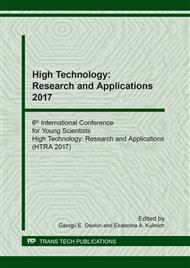[1]
V.S. Levitskii, E.I. Terukov, A.I. Maksimov, V.A. Moshnikov, Investigation of the structure and composition of film sol-gel-derived COOx-SiO2 systems. Phys. Solid State. 56,2(2014)270-275.
DOI: 10.1134/s1063783414020176
Google Scholar
[2]
M. Kawashita, N. Matsui, Zh. Li, T. Miyaza, Preparation of porous yttrium Oxide microparticles by gelation of ammonium alginate in aqueous solution containing yttrium. Ions. J Mater Sci: Mater Med. 21 (2010) 1837-1843.
DOI: 10.1007/s10856-010-4050-4
Google Scholar
[3]
A.S. Zhukov, V.A. Arkhipov, S.S. Bondarchuk, V.D. Gol'din, Evaluation of particle morphology in plasma-chemical synthesis of ceramic powders [in Russian]. Khimicheskaya fizika. 32, 12 (2013) 1-6.
Google Scholar
[4]
V.A. Arkhipov, E.A. Kozlov, I.K. Zharova, S.S. Titov, A.S. Usanina, Evolution of a liquid-drop aerosol cloud in the atmosphere. Arabian Journal of Geosciences. 9 (2016) 1-10.
DOI: 10.1007/s12517-015-2161-4
Google Scholar
[5]
K.P. Sreekumar, S.K. Saxena, T.K. Thiyagarajan, A. Dash, P.V. Ananthapadmanabhan, M. Venkatesh, Studies on the preparation and plasma spherodization of yttrium aluminosilicate glass microspheres for their potential application in liver brachytherapy. J. Phys.: Conf. Ser. 208, (2010).
DOI: 10.1088/1742-6596/208/1/012117
Google Scholar
[6]
V.S. Bessmertnyj, V.P. Krokhin, A.A. Lyashko, N.A. Drizhd, Zh.E. Shekhovtsova, Preparation of glass microspheres by plasma spraying. Steklo i Keramika. 8 (2001) 6-7.
Google Scholar
[7]
I. Gulyaev, Experience in plasma production of hollow ceramic microspheres with required wall thickness. Ceramics International. 41 (2015) 101-107.
DOI: 10.1016/j.ceramint.2014.08.040
Google Scholar
[8]
V. Shekhovtsov et al., Aluminosilicate Microsphere Synthesis in Plasma Flow. Materials Science Forum. 906 (2017) 131-136.
DOI: 10.4028/www.scientific.net/msf.906.131
Google Scholar
[9]
N. I. Vatin, D. V. Petrosov, A. I. Kalachev, P. Lakhtinen, Ash and bottom ash in construction [in Russian]. Inzhenerno-stroitel'nyi zhurnal. 4 (2011) 16-21.
Google Scholar
[10]
G. Itskos, S. Itskos, N. Koukouzas, Size fraction characterization of highly-calcareous fly ash. Fuel Process Technol. 91 (2010) 1558-1563.
DOI: 10.1016/j.fuproc.2010.06.002
Google Scholar
[11]
A.M. Mustafa, A.l. Bakri, et al., Microstructure Studies on the Effect of the Alkaline Activators of Fly Ash-Based Geopolymer at Elevated Heat Treatment Temperature. Applied Mechanics and Materials. 421 (2013) 342-348.
DOI: 10.4028/www.scientific.net/amm.421.342
Google Scholar
[12]
D.V. Oreshkin, K.V. Belyev, V.S. Semenov, U.E. Kretova, Hollow microspheres: an efficient filler for construction and backfill mortars. Industrial and civil engineering. 9 (2010) 50-51.
Google Scholar
[13]
V.V. Shekhovtsov, O.G. Volokitin, Plasma-assisted production of ash-based microspheres with different structure [in Russian]. Tekhnika i tekhnologiya silikatov. 24 (2017) 2-6.
Google Scholar
[14]
V.V. Shekhovtsov, O.G. Volokitin, A.A. Kondratyuk, R. E. Vitske, Fly ash particles spheroidization using low temperature plasma energy. IOP Conf. Series: Materials Science and Engineering. 156 (2016) 012043.
DOI: 10.1088/1757-899x/156/1/012043
Google Scholar
[15]
V.V. Shekhovtsov, G.G. Volokitin, N.K. Skripnikova, O.G. Volokitin, R.E. Gafarov, Plasma treatment of agglomerating aluminosilicate powders based on coal ash. AIP Conference Proceedings. 1800 (2017) 020008.
DOI: 10.1063/1.4973024
Google Scholar
[16]
V.A. Vlasov, O.G. Volokitin, G.G. Volokitin, N.K. Skripnikova, V.V. Shekhovtsov, Calculation of the melting process of a quartz particle under low-temperature plasma conditions. Journal of Engineering Physics and Thermophysics. 89 (2016) 152-156.
DOI: 10.1007/s10891-016-1362-3
Google Scholar
[17]
V.V. Shekhovtsov, V.A. Vlasov, G.G. Volokitin, O.G. Volokitin. Izv. Vyssh. Uchebn. Zaved., Fiz. 59 (2016) 305-305.
Google Scholar
[18]
O.G. Volokitin, V.I. Vereshchagin, G.G. Volokitin, N.K. Skripnikova, V.V. Shekhovtsov, Analysis of traditional and plasma-assisted melting of bottom ash generated by power plants [in Russian]. Tekhnika i tekhnologiya silikatov. 23 (2016) 2-5.
DOI: 10.1063/1.4937849
Google Scholar
[19]
V.V. Shekhovtsov, O.G. Volokitin, G.G. Volokitin, N.K. Skripnikova, A.S. An'shakov, V.I. Kuz'min, Thermal plasma effect on ceramic microsphere formation. Part 1. Heating and evaporation [In Russian]. Vestnik TSUAB. 64 (2017) 143-150.
DOI: 10.4028/www.scientific.net/msf.906.131
Google Scholar


